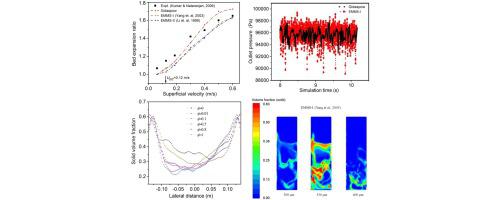Particuology ( IF 3.5 ) Pub Date : 2019-12-26 , DOI: 10.1016/j.partic.2019.10.004 Krishnadash S. Kshetrimayum , Seongho Park , Chonghun Han , Chul-Jin Lee

|
The energy minimization multi-scale (EMMS) is a heterogeneous drag model widely used to simulate gas–solid fluidized beds. In this work, we conducted computational fluid dynamics simulations of a gas–solid fluidized bed for Geldart B particles to compare the EMMS with the homogeneous Gidaspow drag model. The results from both the homogeneous and heterogeneous drag models were compared with literature experimental data on pressure drop and bed expansion. There was no noticeable difference in predicted bed characteristics in the slugging regime. However, in the turbulent regime, the EMMS model predicted slightly lower bed expansion than did the Gidaspow model. We evaluated the effects of solid–solid and solid–wall interaction parameters by varying the restitution and specularity coefficients. Bed expansion increases by a factor of 1.05–1.08 when the restitution coefficient increases from 0.9 to 0.99. The models predict a higher solid volume fraction and higher solid downflow velocity near the wall for a low specularity coefficient of 0.01 or 0. When we considered solid phases of different sizes to model polydisperity, the simulation predicted vertical segregation of 300, 350, and 400 μm in the fluidized region due to gravity. Furthermore, the drag models made similar predictions in bad characteristics from cold model simulation of a polysilicon fluidized-bed reactor, although there was very little vertical segregation of solid particles for this case.
中文翻译:

用于模拟Geldart B颗粒的气固流化床的EMMS阻力模型:床模型参数和多分散性的影响
最小能量多尺度(EMMS)是一种异质阻力模型,广泛用于模拟气固流化床。在这项工作中,我们对Geldart B颗粒的气固流化床进行了计算流体动力学模拟,以将EMMS与均质的Gidaspow阻力模型进行比较。将均质和非均质阻力模型的结果与有关压降和床层膨胀的文献实验数据进行了比较。在拍打状态下,预测的床特性没有显着差异。但是,在湍流状态下,EMMS模型预测的河床扩张比Gidaspow模型略低。我们通过改变回复和镜面反射系数来评估固-固和固-壁相互作用参数的影响。床膨胀量增加1.05-1倍。恢复系数从0.9增加到0.99时为08。对于低镜面系数0.01或0,模型预测壁附近有更高的固相体积分数和更高的固体向下流动速度。当我们考虑使用不同尺寸的固相来模拟多分散性时,模拟预测了300、350和400的垂直偏析在重力作用下流化区域的微米。此外,尽管在这种情况下,固体颗粒的垂直分离非常少,但从多晶硅流化床反应器的冷模型模拟中,阻力模型对不良特性做出了相似的预测。当我们考虑不同大小的固相来模拟多分散性时,该模拟预测由于重力的作用,流化区域中的垂直偏析分别为300、350和400μm。此外,尽管在这种情况下,固体颗粒的垂直分离非常少,但从多晶硅流化床反应器的冷模型模拟中,阻力模型对不良特性做出了相似的预测。当我们考虑不同大小的固相来模拟多分散性时,该模拟预测由于重力的作用,流化区域中的垂直偏析分别为300、350和400μm。此外,尽管在这种情况下,固体颗粒的垂直分离非常少,但从多晶硅流化床反应器的冷模型模拟中,阻力模型对不良特性做出了相似的预测。



























 京公网安备 11010802027423号
京公网安备 11010802027423号